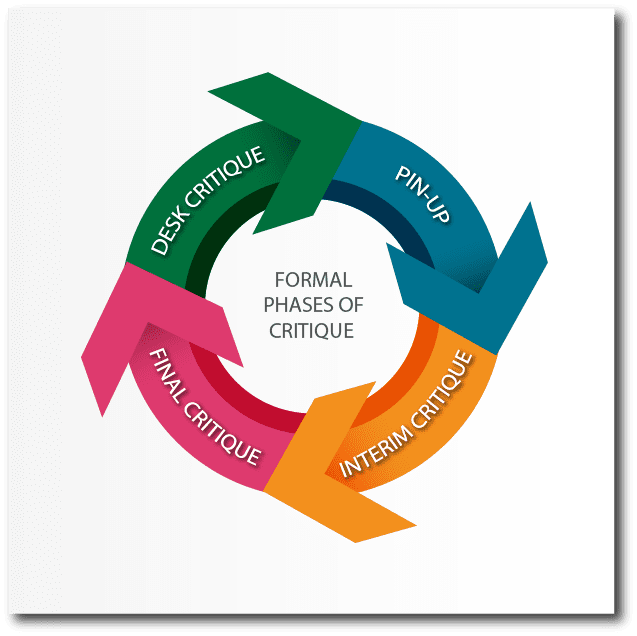Studio Teaching
What is Studio Teaching?
-
Studio-based teaching focuses on problem/project work and experimentation in a hands-on studio environment. Traditionally found in the arts and architecture and is used in other fields such as Instructional Technology and the sciences.
-
Studio teaching is an approach to teaching that can be used to replace the standard lecture approach..
-
Studio teaching (Jeffery A. Lackney, 1999 (Mississippi State, Educational Design Institute) Elements include the design problem/project, lectures, and four phases of critique: the design “crit” by the instructor; the “pin-up’ involving peer review; the interim or mid term crit and the final crit, both of which involve juries. An exit interview may also be conducted as part of the evaluation process http://www.edi.msstate.edu/work/pdf/history_studio_based_learning.pdf
Why use Studio Teaching?
-
Experience has shown that students learn technical skills more efficiently and incorporate them more readily into the building design process when the skills are acquired on an as-needed basis during ongoing design projects (Allen, 1997)
-
All courses are secondary to the studio assignment, both in terms of the number of units and hours devoted by students in this atelier-like setting. Each term, students evaluate their studio by the problem or problems given and by the professor. The studio problems are important first because they must hold the studentsí undivided attention for a term, and second because students include these design solutions in the portfolios they later present to prospective employers (Lackney, 1999)
-
The typical studio instructor is a practicing architect who provides a living example of what it means to be a designer. In studio, students gather the individual instructor’s method and Weltanschauung, and with each new studio another possible approach to architecture is layered upon the last, from which students will determine their own professional course (Cuff, 1991; 121) (Lackney, 1999)
Getting started with Teaching Studios
(Lackney, 1999)

Design Problem: Students are given background knowledge about a design problem and collaborate in doing research on the general issues, which is shared with the entire studio class

Design solutions: Students’ work is of an individual nature resulting in a variety of alternative design solutions

Weekly Lectures: Supplementary lectures from the professor on various aspects of the problem are given on a weekly basis to the entire class in which a number of design precedents are reviewed and critiqued.

Special Skills and Techniques: The professor may provide lectures and demonstrations concerning special skills and techniques required to successfully address the problems

Formal Phases of Critique

-
Desk Critique: A twenty to thirty minute dialogue between student and studio instructor occurs daily or twice a week. The instructor reviews the quality of the student’s process of design inquiry and ability to reflect on their own process of designing. The instructor reviews the student’s progress in solving the design problem and gives critical feedback on the student’s process and product. . A product is required by the instructor but the student may have choice in representation of the solution depending on their level of skill and knowledge.
-
Revisions: The studio instructor suggests particular revisions in the design that he or she feels will better solve a particular aspect of the problem. Following the desk crit, the student is expected to more fully explore and test these options and suggestions by revisiting his or her solution. The student may produce dozens of design iterations. The studio instructor will then review the outcome of the studentís revised solution suggesting further changes and refinements. This process of revisiting and revising alternative design solutions is referred to as ìdesign iterationî. (Lackney, 1999)
-
Modeling: The instructor acts as master to apprentices by modeling behavior, thought processes, values, design strategies, and describing some features of the process being demonstrated.
-
Peer-Critiques: Concurrent with the desk critique, students informally critique each other’s work throughout the semester, learning design skills from each other. Students learn to distinguish between well and poorly designed solutions.
-
-
Pin-up: This is a form of peer-review. The student formally presents his or her work to the studio class and instructor, restates the problem, outlines the issues being addressed to solve the problem, presents the solution and describes the process by which they arrived at a tentative solution. Then the work is open to critique and discussion by the class and instructor. Specific and general comments may be made to the class as a whole about certain aspects of the problem raised by the project. If the objective is to obtain general comments the crit involves simultaneous critique of 3-5 projects as once.
-
Interim or Mid Term Crit: Students present their best solutions to a jury of studio instructors, practitioners and clients familiar with the design problem in practice. Students wait their turn to present to the jury and takes several hours.
-
Final Crit: Many of the same jurists, but often highly regarded and respected jurists are formally invited. The final crit can involve large audiences of students and local experts. Jurors often fill out pre-determined score cards that are given to the instructor.
-
Oregon Crit: Developed at the University of Oregon, students display their work similar to a science fair and jurors walk from project to project, providing one-on-one critique. Students present their project more than one over the period and gain a fuller understanding of the project’s strengths and weaknesses.
-
References:
Lackney, J. A. (1999, August 2). A History of the Studio-based Learning Model. Retrieved from http://www.edi.msstate.edu/work/pdf/history_studio_based_learning.pdf
Science Education Research Center. (n.d.). What is a studio classroom? Retrieved from https://serc.carleton.edu/introgeo/studio/what.html
Cornell University Center for Teaching and Learning Innovation. (n.d.). Teaching Studios. Retrieved from https://www.cte.cornell.edu/teaching-ideas/labs-studios-discussions/teaching-studios.html
Michigan State University Academic Advancement Network. (n.d.). Studio Teaching. Retrieved from http://fod.msu.edu/oir/studio-teaching
Illustration credit: Vecteezy! Illustrations by Vecteezy! Icons made by Geotatah from www.flaticon.com